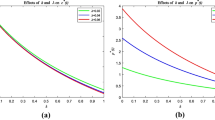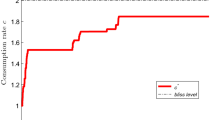Abstract
We find the optimal investment strategy to minimize the expected time that an individual’s wealth stays below zero, the so-called occupation time. The individual consumes at a constant rate and invests in a Black-Scholes financial market consisting of one riskless and one risky asset, with the risky asset’s price process following a geometric Brownian motion. We also consider an extension of this problem by penalizing the occupation time for the degree to which wealth is negative.
Similar content being viewed by others
References
Akahori, J. (1995). Some formulae for a new type of path-dependent option. Annals of Applied Probability, 5, 91–99.
Bayraktar, E., & Young, V. R. (2007). Correspondence between lifetime minimum wealth and utility of consumption. Finance and Stochastics, 11(2), 213–236.
Brémaud, P. (1981). Point Processes and Queues. Berlin: Springer.
Doney, R. A., & Yor, M. (1998). On a formula of Takács for Brownian motion with drift. Journal of Applied Probability, 35, 272–280.
Hugonnier, J. (1999). The Feynman-Kac formula and pricing occupation time derivatives. International Journal of Theoretical and Applied Finance, 2, 153–178.
Karatzas, I., & Shreve, S. E. (1991). Brownian Motion and Stochastic Calculus. New York: Springer.
Karatzas, I., & Shreve, S. E. (1998). Methods of Mathematical Finance. New York: Springer.
Linetsky, V. (1999). Step options. Mathematical Finance, 9, 55–96.
Milevsky, M. A., Moore, K.S., & Young, V. R. (2006). Asset allocation and annuity-purchase strategies to minimize the probability of financial ruin. Mathematical Finance, 16(4), 647–671.
Moore, K. S., & Young, V. R. (2006). Optimal and simple, nearly optimal rules for minimizing the probability of financial ruin in retirement. North American Actuarial Journal, 10(4), 145–161.
Neuts, M. F. (1989). Structured Stochastic Matrices of M/G/1 Type and Their Applications. New York: Dekker.
Pechtl, A. (1999). Distribution of occupation times of Brownian motion with drift. Journal of Applied Mathematics and Decision Sciences, 3, 41–62.
Takács, L. (1996). On a generalization of the arc-sine law. Annals of Applied Probability, 6, 1035–1040.
Author information
Authors and Affiliations
Corresponding author
Additional information
E. Bayraktar is supported in part by the National Science Foundation.
Rights and permissions
About this article
Cite this article
Bayraktar, E., Young, V.R. Optimal investment strategy to minimize occupation time. Ann Oper Res 176, 389–408 (2010). https://doi.org/10.1007/s10479-008-0467-2
Published:
Issue Date:
DOI: https://doi.org/10.1007/s10479-008-0467-2




